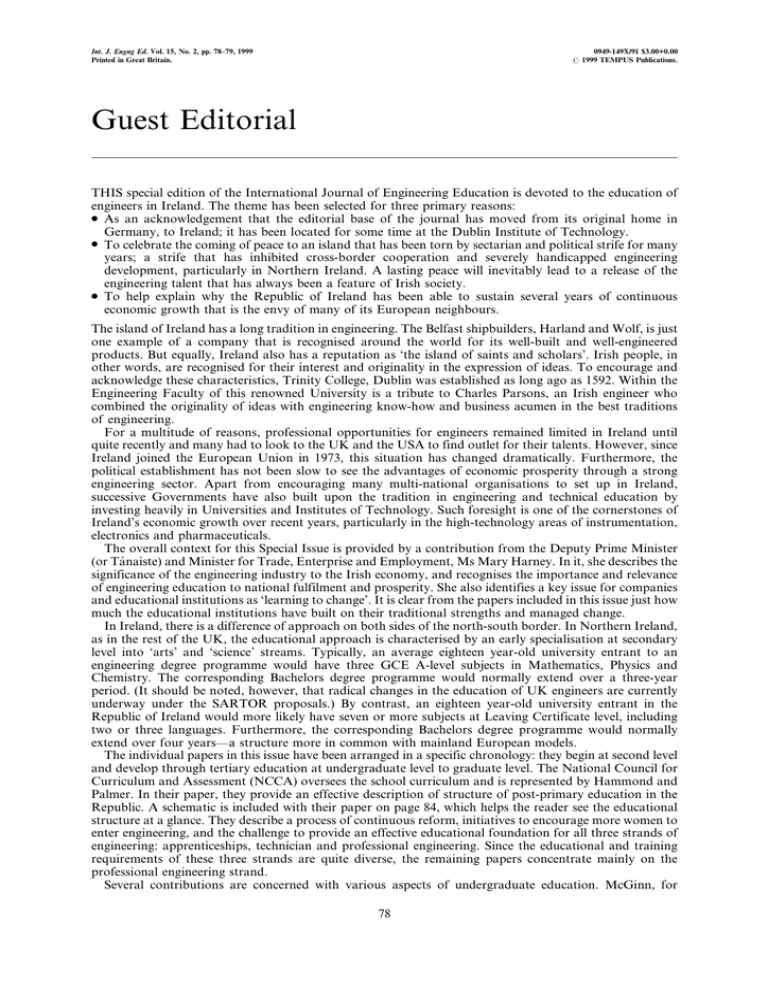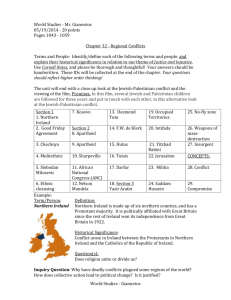Int. J. Engng Ed. Vol. 15, No. 2, pp. 78±79,... 0949-149X/91 $3.00+0.00 Printed in Great Britain. # 1999 TEMPUS Publications.
advertisement

Int. J. Engng Ed. Vol. 15, No. 2, pp. 78±79, 1999 Printed in Great Britain. 0949-149X/91 $3.00+0.00 # 1999 TEMPUS Publications. Guest Editorial THIS special edition of the International Journal of Engineering Education is devoted to the education of engineers in Ireland. The theme has been selected for three primary reasons: . As an acknowledgement that the editorial base of the journal has moved from its original home in Germany, to Ireland; it has been located for some time at the Dublin Institute of Technology. . To celebrate the coming of peace to an island that has been torn by sectarian and political strife for many years; a strife that has inhibited cross-border cooperation and severely handicapped engineering development, particularly in Northern Ireland. A lasting peace will inevitably lead to a release of the engineering talent that has always been a feature of Irish society. . To help explain why the Republic of Ireland has been able to sustain several years of continuous economic growth that is the envy of many of its European neighbours. The island of Ireland has a long tradition in engineering. The Belfast shipbuilders, Harland and Wolf, is just one example of a company that is recognised around the world for its well-built and well-engineered products. But equally, Ireland also has a reputation as `the island of saints and scholars'. Irish people, in other words, are recognised for their interest and originality in the expression of ideas. To encourage and acknowledge these characteristics, Trinity College, Dublin was established as long ago as 1592. Within the Engineering Faculty of this renowned University is a tribute to Charles Parsons, an Irish engineer who combined the originality of ideas with engineering know-how and business acumen in the best traditions of engineering. For a multitude of reasons, professional opportunities for engineers remained limited in Ireland until quite recently and many had to look to the UK and the USA to find outlet for their talents. However, since Ireland joined the European Union in 1973, this situation has changed dramatically. Furthermore, the political establishment has not been slow to see the advantages of economic prosperity through a strong engineering sector. Apart from encouraging many multi-national organisations to set up in Ireland, successive Governments have also built upon the tradition in engineering and technical education by investing heavily in Universities and Institutes of Technology. Such foresight is one of the cornerstones of Ireland's economic growth over recent years, particularly in the high-technology areas of instrumentation, electronics and pharmaceuticals. The overall context for this Special Issue is provided by a contribution from the Deputy Prime Minister (or TaÂnaiste) and Minister for Trade, Enterprise and Employment, Ms Mary Harney. In it, she describes the significance of the engineering industry to the Irish economy, and recognises the importance and relevance of engineering education to national fulfilment and prosperity. She also identifies a key issue for companies and educational institutions as `learning to change'. It is clear from the papers included in this issue just how much the educational institutions have built on their traditional strengths and managed change. In Ireland, there is a difference of approach on both sides of the north-south border. In Northern Ireland, as in the rest of the UK, the educational approach is characterised by an early specialisation at secondary level into `arts' and `science' streams. Typically, an average eighteen year-old university entrant to an engineering degree programme would have three GCE A-level subjects in Mathematics, Physics and Chemistry. The corresponding Bachelors degree programme would normally extend over a three-year period. (It should be noted, however, that radical changes in the education of UK engineers are currently underway under the SARTOR proposals.) By contrast, an eighteen year-old university entrant in the Republic of Ireland would more likely have seven or more subjects at Leaving Certificate level, including two or three languages. Furthermore, the corresponding Bachelors degree programme would normally extend over four yearsÐa structure more in common with mainland European models. The individual papers in this issue have been arranged in a specific chronology: they begin at second level and develop through tertiary education at undergraduate level to graduate level. The National Council for Curriculum and Assessment (NCCA) oversees the school curriculum and is represented by Hammond and Palmer. In their paper, they provide an effective description of structure of post-primary education in the Republic. A schematic is included with their paper on page 84, which helps the reader see the educational structure at a glance. They describe a process of continuous reform, initiatives to encourage more women to enter engineering, and the challenge to provide an effective educational foundation for all three strands of engineering: apprenticeships, technician and professional engineering. Since the educational and training requirements of these three strands are quite diverse, the remaining papers concentrate mainly on the professional engineering strand. Several contributions are concerned with various aspects of undergraduate education. McGinn, for 78 Guest Editorial 79 example, writes about the experience of the University of Limerick in relation to industrial placement as a compulsory element of undergraduate education. Murphy and Turner of the Dublin Institute of Technology, help explain the changing educational role of institutions which traditionally concentrated on technician training but which are now increasingly developing their own professional engineering programmes. This theme is continued by McLaughlin but from a perspective of student motivation, preparation and programme relevance. Keane and Gibson, present the results of a joint survey of practising professional engineers into the content and relevance of communications courses for undergraduate engineers. New innovations in undergraduate programmes are addressed in two papers. Clarke and McClelland describe a new degree programme that combines the strengths of the School of Engineering and the School of Art and Design at the University of Ulster. Wade, Grimson and Power examine the impact of Web-based learning through an evaluation of a course on database technology. McGinnity, Maguire and McDaid continue the theme of Web-based learning as they describe a Masters programme developed between three institutions spread across Ireland: the University of Ulster, Athlone Institute of Technology, and the National University of Ireland, Galway. From Northern Ireland, Clarke and Thompson provide a quality evaluation of a novel Integrated Graduate Development Scheme (IGDS) that was developed between two universities, engineering industry and government organisations. In the final paper of this Special Issue, Gilchrist describes a project-based learning approach, which integrates academic learning and industrial experience at graduate level. The increased emphasis on communications for engineers, the widespread adoption of web-based and project-based learning, and the development of inter-institutional programmes are all features of a modern, flexible approach to the provision of education for engineers. Hopefully, readers will find many parallels between their own interests and experiences and themes contained in this issue. As stated earlier, the key issue for companies and educational institutions is learning to change. This collection of papers provides an insight into the extent of change from an Irish perspective, which will, I feel sure, draw many international parallels. As Guest Editor, I would like to thank all the authors for responding so well to requests for papers and for providing completed copies in good time for publication. Due to pressures of space, I regret that a few papers could not be accommodated in this special issue. However, their contributions have been accepted for publication in future editions of the Journal. Dr. Ivan S. Gibson National University of Ireland Galway E-mail: ivan.gibson@nuigalway.ie






